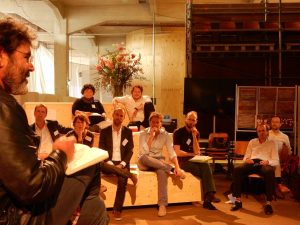Summarizing the first day….
Yesterday was the first of a three day exploration of the dynamics of urban change from the perspective of an amazing group of change agents from several countries. They were from South Africa, Indonesia, Brazil, China, Uganda and The Netherlands. Edgar Pieterse gave a challenging and inspiring keynote, delivered with passion and precision. His message was that there was beauty in dissonance – a challenging message in consensus-oriented The Netherlands and a reflection of endemically conflict South Africa. Case studies were presented by the change agents from different parts of the world, with Zahira Asmal talking about her work as a publisher of stories of SA cities, and me reflecting on the iShack initiative. The case studies were all about inclusion in fast changing urban environments: informal settlement upgrading in Rio, the people who live underground in Beijing, coalitioning to build livelihoods in Bandung, building a market amidst new highways in Kampala and neighbourhood-based cooperative initiatives in The Netherlands to resist exclusion via gentrification. Guided by skilled facilitators who kind of replicated in real time live form what we have come to expect in our new website-based learning culture – multiple messaging, rapid shifts in environments, changing angles on the same theme, hyperlinks to related conversations. I summed up at the end building on two ideas: Maarten Hajer’s opening proposition as we face mounting global crises we are less and less able to trust states to address these challenges, resulting in the rising of the energetic society of multiple change agents; and Edgar’s suggestion that the change agent needs a range of connected capabilities – ethicist, artist, hacker, designer and bureaucrat. Still working out the ideas, I ventured into an academic discourse that lost quite a few in the group, but nevertheless what I was trying to grapple with is a way of understanding the new phenomenon of the change agent who plays such a key role around the world. I suggested that we needed to get away from a focus on the heroic individual as depicted in the work of the Ashoka Fellowship, Skol Foundation and many others involved in replicating the model of the heroic individual entrepreneur drawn from the capitalist myth within the social entrepreneurship space. I also suggested that network theory places too much emphasis on the constitutive role of the network and insufficient emphasis on the actor. I then proposed an alternative which is about discovering the DNA of the change agent’s practices, and in particular how they activate purpose-built networks. How do these networks get constituted? Are there inner and outer rings? How do they overlap with other networks? Who gets included and excluded? How are decisions made by the change agent to activate this or that part of his/her networks to achieve different ends? How to network-based actions translate into more formal representations, negotiations and deals? What kind of trust gets built? What are the reciprocities? What threatens them? These questions emerged from a discussion between Edgar, Maarten and myself during the break and they are clearly worth exploring in the future if we want to replicate what change agents do as part of building up an energetic society.


Recent Comments